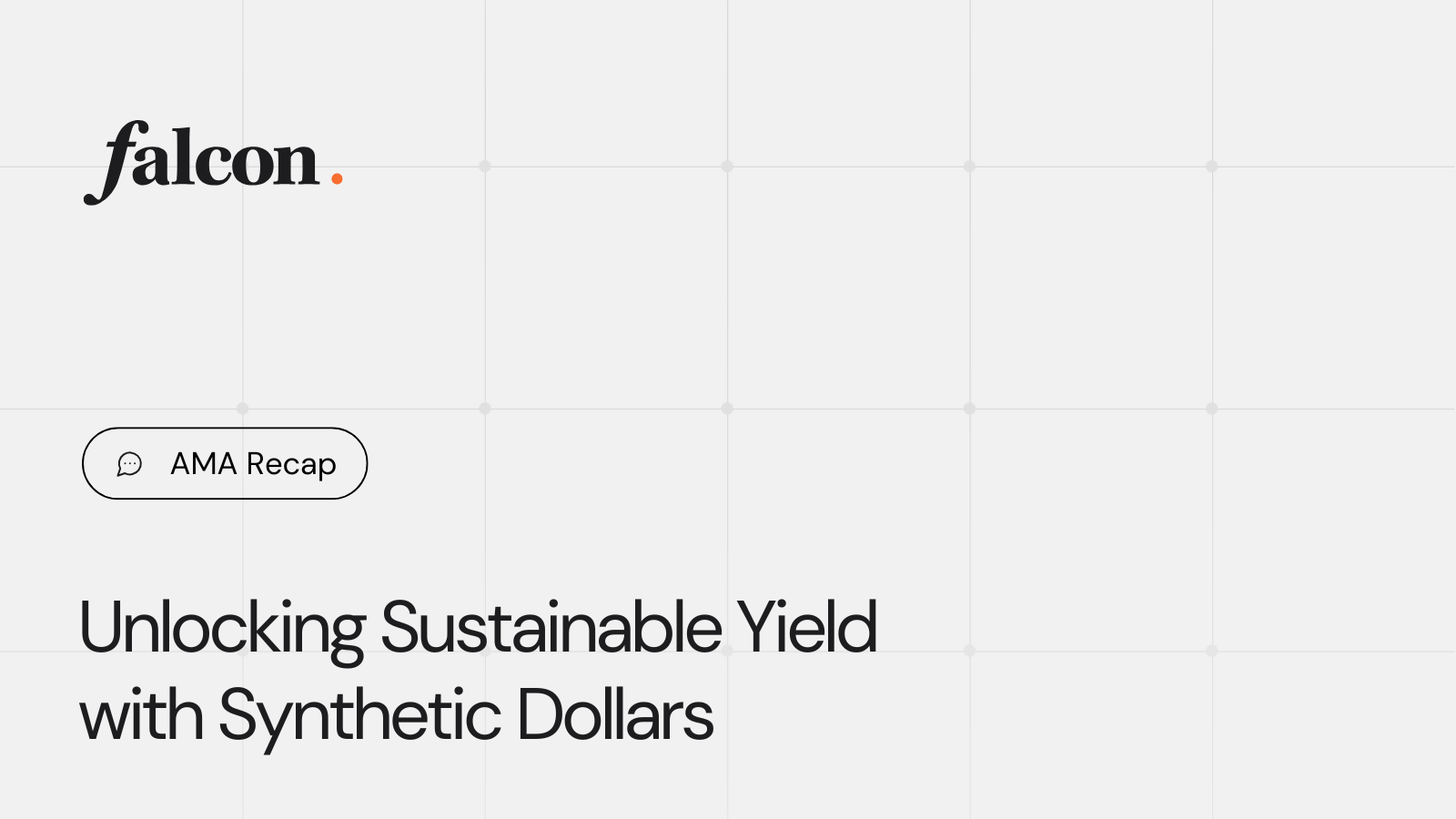Falcon AMA Recap: Unlocking Sustainable Yield with Synthetic Dollars
Updated • 15 Aug 2025
Published • 20 Jun 2025
4 mins

Falcon Finance was recently invited to a Chinese-language Twitter Space hosted by Bitget Wallet CN, where our Partner Lingling Jiang, also Partner at DWF Labs, joined fellow guests 猴叔 and 杰克李 to explore how synthetic dollars are evolving and what it takes to deliver consistent yield in the Web3 environment.
The session provided a deep dive into how USDf works, why multi-asset collateral matters, and how everyday users can start earning with DeFi tools that don’t require advanced technical knowledge.
Since launching in February 2025, Falcon Finance has focused on building a new kind of synthetic dollar: one that is yield-bearing, transparent, and accessible to all. As Lingling explained during the AMA, “We’ve designed Falcon so even an 80-year-old grandma could use it comfortably.”
So what is Falcon Finance and what is it building? Let’s take a closer look at the features Lingling covered during the AMA.
USDf is Falcon’s overcollateralized synthetic dollar:
- Mintable with both major (BTC, ETH, USDC) and long-tail assets (TON, APT, MEDIA, and more)
- Stakeable for yield
- Supported by transparent proof of reserves, audited quarterly by ht.digital
- Built with safety, flexibility, and scale in mind
During the AMA, yield surfaced as a central theme. In response, Lingling shared the four-pronged strategy Falcon uses to keep rates competitive regardless of market cycles:
- Positive funding arbitrage – Buy spot, short perp to capture funding
- Negative funding arbitrage – Sell spot, long perp when funding is negative
- Cross-exchange arbitrage – Profit from price gaps across exchanges
- Native staking – Stake collateral assets for base yield (e.g. ETH, SOL)
“We don’t rely on just one model,” she emphasized. “We combine strategies to stay resilient through both bull and bear markets.”
This is an important note to highlight. Because as regulatory momentum builds globally, synthetic dollars are no longer just a niche DeFi tool. Lingling highlighted that legislation like the U.S. Genius Act and regulatory frameworks in Hong Kong are accelerating synthetic dollar adoption.
“Synthetic dollars are becoming the intuitive bridge from Web2 and TradFi into Web3,” she said, pointing to institutions like J.P. Morgan, Visa, and PayPal that are entering the space. Falcon sees this as validation that the next wave of adoption will be powered by the rise of synthetic dollars and related assets.
Another topic highlighted during the AMA was the newly-launched Falcon Miles program, which rewards users across the ecosystem. “Anyone minting, staking, or holding USDf will earn points,” Lingling shared.
Miles can be earned for:
- Minting USDf (with 8x bonus for non-stablecoin collateral)
- Staking or restaking USDf
- Social and partner campaign engagement (e.g. Morpho, Pendle)
A question in the AMA was if a new user had $1000 USD worth of a synthetic dollar, how would they best utilize it through Falcon? Lingling shared a concrete example:
- Mint 1,000 USDf at a 1:1 ratio
- Stake it to earn sUSDf
- Alternatively, LP in Curve’s USDf/USDC pool to aim for 15–20% APY – USDf has multiple liquidity pools available across various DeFi protocols and DEXes
- Advanced users can loop: borrow against sUSDf, re-mint, and restake
Whether you're new to DeFi or already optimizing capital across protocols, Falcon provides options that meet you where you are.
Another core pillar Lingling had emphasized during the AMA was the protection of user funds, which Falcon takes multiple steps to ensure:
- All collateral is tracked live on Falcon’s Proof of Reserves dashboard
- Third-party audits are conducted quarterly by ht.digital
- Mint caps and liquidation thresholds are actively managed based on market conditions
“Even if your initial deposited collateral drops in price, your redeemable USDf value remains protected,” she noted.
Now looking at what’s ahead, we see strong growth in Falcon’s TVL, and more strategies are being deployed to scale yield. Lingling acknowledged that while APY may fluctuate slightly, the team remains focused: “Since launch, our APY has generally stayed above 10%, and we expect it to rise again as new strategies roll out.”
In conclusion, this AMA made one thing clear: yield doesn’t have to be complicated. With its diversified strategy, transparent design, and inclusive UX, Falcon is building a foundation for sustainable returns that anyone, from crypto native to newcomer, can use.
We’re just getting started. Start earning with Falcon.
Tags